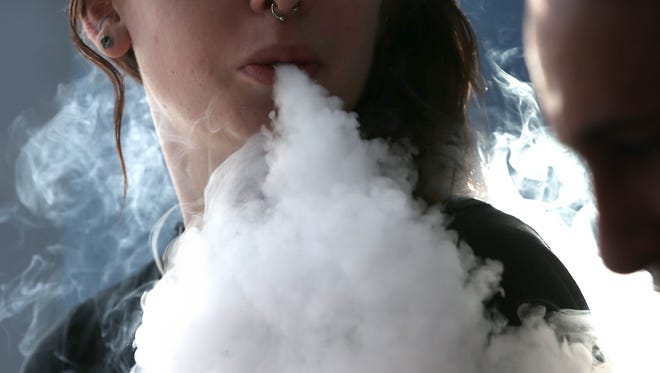Study: New concerns raised over teen e-cigarette use

As e-cigarette use among teens rapidly increases, a national health report suggests adolescents who would not have otherwise used tobacco products are now turning to electronic smoking devices.
The report, released Monday by the American Academy of Pediatrics, is based on a study that found overall smoking prevalence among youth in Southern California declined, but the combined e-cigarette or cigarette use was substantially greater than before e-cigarettes became available.
The conclusion raises the question of whether e-cigarettes are merely substituting for cigarettes or being used by teens who wouldn’t otherwise be smoking.
In 2014, the Centers for Disease Control and Prevention reported e-cigarettes were the most commonly used tobacco product among middle and high school students, with an estimated 2 million users in that age group.
Cigarette smoking declined among American teens in recent years, but the use of other tobacco products — like e-cigarettes and hookahs — increased, the report says.
More teens now try vaping than smoking
The potential safety of e-cigarettes, devices that heat a liquid consisting of nicotine, flavorings and other chemicals to create a vapor, is hotly debated. Unlike traditional cigarettes, e-cigarettes do not contain tar or other chemicals generated by the combustion of tobacco that are responsible for harmful tobacco-related diseases. They are, therefore, seen as a safer alternative to conventional tobacco use, the leading cause of preventable death in the U.S.
Health care experts worry e-cigarettes could normalize cigarette use and create a new generation of smokers and nicotine addicts that will be likely to transition to more traditional tobacco products.
But Brian Carter, the director of scientific communications at The Consumer Advocates for Smoke-free Alternatives Association, a group dedicated to ensuring the availability of smoking alternatives, asks why someone who prefers not to smoke but tries e-cigarettes would make the transition to a “really nasty alternative.”
Aruni Bhatnagar, lead author of the American Heart Association’s policy statement on e-cigarettes, said even if teens don’t switch to other tobacco products, nicotine itself isn’t benign. It increases heart rate and blood pressure and can, over time, contribute to cardiovascular and heart disease, he said.
“We are not entirely convinced that (e-cigarettes) are innocuous and contain minimal harm,” said Bhatnagar, who also teaches medicine at the University of Louisville. “We don’t know what the harm is, it’s not clear cut yet.”
Tobacco use and addiction mostly begin during youth and young adulthood. Nicotine exposure during adolescent years, a critical time for brain development, can have lasting adverse consequences, according to the CDC report.
Harold Farber, policy chair at the American Academy of Pediatrics Section on Tobacco Control and pediatric pulmonologist at Texas Children’s Hospital, said the adolescent brain is highly malleable, so addiction to nicotine is much more severe and difficult to kick in those who start using at a young age.
E-cigarettes, which are sold in a variety of different flavors, are like a highly addictive candy directly marketed to youth, Farber said.
Gregory Conley, president of the American Vaping Association, an advocacy group that champions vapor products for smokers looking to quit, argued most teens who do use e-cigarettes aren’t necessarily using vapes that contain nicotine.
A 2015 National Institute on Drug Abuse report says over 60% of middle and high school students reported vaporizing “just flavoring.” However, some products labeled nicotine-free may actually contain nicotine, it added.
The Food and Drug Administration issued new rules in May that for the first time extended federal regulation to e-cigarettes, with the intent to keep tobacco products out of the hands of minors.
The new rules ban the sale of e-cigarettes to anyone under 18 and require manufacturers to register with the FDA, disclose detailed reports of their products’ ingredients and obtain permission to sell their products.
FDA went way too far on e-cigarettes
While these regulations are a move in the right direction, Bhatnagar says they could have gone even farther by increasing the age to 21, banning the different e-cigarette flavors and regulating advertisements on TV and in magazines.
Bhatnagar says smoking was de-normalized when it was banned from public spaces and discouraged from display in TV and movies, which he credits for the major gains in decreased tobacco use and addiction. But vaping, which people do publicly in a variety of different environments, reverses these gains, he said.
Carter, who has a background in clinical psychology, argues it is highly premature to conclude that “something bad is going on” with youth e-cigarette use.
“At best, this is a study that offers some small potential clue about what may be happening,” he said. “To suggest anything more concrete than this is to be very unscientific by touting speculation as fact.”
Farber says e-cigarettes are a huge experiment to be conducting on our future generations.
“With e-cigarettes we’re seeing a step back in our battle,” he said. “But I’m hoping we realize the errors of our ways and decide it’s worth protecting our children.”
Follow Karina Shedrofsky on Twitter: @karinashed